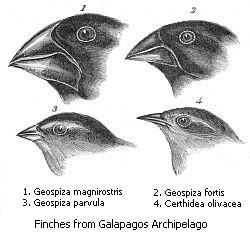
In evolutionary biology, adaptive radiation is a process in which organisms diversify rapidly from an ancestral species into a multitude of new forms, particularly when a change in the environment makes new resources available, alters biotic interactions or opens new environmental niches. Starting with a single ancestor, this process results in the speciation and phenotypic adaptation of an array of species exhibiting different morphological and physiological traits. The prototypical example of adaptive radiation is finch speciation on the Galapagos, but examples are known from around the world.
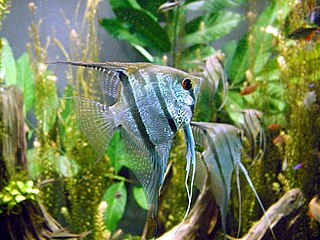
Cichlids are fish from the family Cichlidae in the order Cichliformes. Cichlids were traditionally classed in a suborder, Labroidei, along with the wrasses (Labridae), in the order Perciformes but molecular studies have contradicted this grouping. The closest living relatives of cichlids are probably the convict blennies and both families are classified in the 5th edition of Fishes of the World as the two families in the Cichliformes, part of the subseries Ovalentaria. This family is both large and diverse. At least 1,650 species have been scientifically described, making it one of the largest vertebrate families. New species are discovered annually, and many species remain undescribed. The actual number of species is therefore unknown, with estimates varying between 2,000 and 3,000.
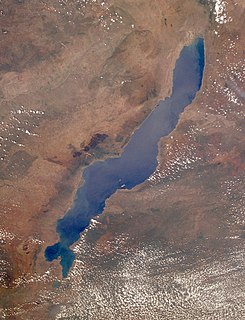
Lake Malawi, also known as Lake Nyasa in Tanzania and Lago Niassa in Mozambique, is an African Great Lake and the southernmost lake in the East African Rift system, located between Malawi, Mozambique and Tanzania.

Lake Victoria is one of the African Great Lakes.

Lake Tanganyika is an African Great Lake. It is the second-oldest freshwater lake in the world, the second-largest by volume, and the second-deepest, in all cases after Lake Baikal in Siberia. It is the world's longest freshwater lake. The lake is shared between four countries – Tanzania, the Democratic Republic of the Congo (DRC), Burundi, and Zambia, with Tanzania (46%) and DRC (40%) possessing the majority of the lake. It drains into the Congo River system and ultimately into the Atlantic Ocean.

The Guinea turaco, also known as the green turaco or green lourie, is a species of turaco, a group of otidimorphae birds belonging to the family Musophagidae. It was formerly included in the Livingstone's, Schalow's, Knysna, black-billed and Fischer's turacos as subspecies.
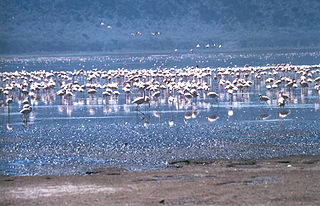
The Rift Valley lakes are a series of lakes in the East African Rift valley that runs through eastern Africa from Ethiopia in the north to Malawi in the south, and includes the African Great Lakes in the south. These include some of the world's oldest lakes, deepest lakes, largest lakes by area, and largest lakes by volume. Many are freshwater ecoregions of great biodiversity, while others are alkaline "soda lakes" supporting highly specialised organisms.

Cicada killer wasps are large, solitary, ground dwelling, predatory wasps. They are so named because they hunt cicadas and provision their nests with them, after stinging and paralyzing them. There are 21 species worldwide. The highest diversity occurs in the region between North Africa and Central Asia.

Mayaheros urophthalmus, also known as the Mayan cichlid or Mexican mojarra is a species of cichlid.

Vieja is a genus of cichlid fish from the Pacific slope of Central America and Mexico. The majority of the species are freshwater fish found in stagnant or slow-moving waters of southern Mexico to El Salvador, but V. maculicauda, which also occurs in brackish waters, ranges south to Panama. They are high-bodied cichlids that reach lengths of up to 17–35 cm (6.7–13.8 in) depending on the exact species. Historically, Vieja was included in Cichlasoma. Once recognized as its own genus, it first included most of the superficially similar, relatively large and high-bodied cichlids of Central America and southern Mexico, but several of these are now considered to belong to separate genera: Chuco, Cincelichthys, Isthmoheros, Kihnichthys, Maskaheros and Oscura. Vieja feed mostly on vegetable matter, but may also take small invertebrates.

Amphilophus is a genus of cichlid fishes from Central America, ranging from southern Mexico to Panama. The genus currently contains 23 species, including several that are well-known from the aquarium trade. However, studies led by Oldrich Říčan in 2008 and 2016 suggested that several species within Amphilophus should be moved to the genus Astatheros. Species proposed to be moved to Astatheros in 2008 were A. alfari, A. altifrons, A. bussingi, A. diquis, A. longimanus, A. macracanthus, A. margaritifer, A. rhytisma, A. robertsoni and A. rostratus. Further genetic studies led Říčan to put A. macracanthus in Astatheros, but to put A. alfari, A. altifrons, A. bussingi, A. diquis, A. longimanus, A. rhytisma, A. robertsoni and A. rostratus within the genus Cribroheros. Říčan's study suggests that the Astatheros species are more closely related to the Jack Dempsey and rainbow cichlid than to the remaining Amphilophus species.

The haplochromine cichlids are a tribe of cichlids in subfamily Pseudocrenilabrinae called Haplochromini. This group includes the type genus (Haplochromis) plus a number of closely related genera such as Aulonocara, Astatotilapia, and Chilotilapia. They are endemic to eastern, southern and northern Africa, except for Astatotilapia flaviijosephi in the Middle East. A common name in a scientific context is East African cichlids – while they are not restricted to that region, they are the dominant Cichlidae there. This tribe was extensively studied by Ethelwynn Trewavas, who made major reviews in 1935 and 1989, at the beginning and at the end of her career in ichthyology. Even today, numerous new species are being described each year.

The Texas cichlid is a freshwater fish of the cichlid family. This is the only cichlid species that is native to the United States. The fish, also known as Rio Grande cichlid, originates from the lower Rio Grande drainage in Texas near Brownsville and Northeastern Mexico.
Iranocichla hormuzensis also known as the Iranian Cichlid is a species of mouthbrooding fish from the cichlid family. It is restricted to freshwater and brackish habitats in the drainage of the Mehran River in southern Iran above the Straits of Hormuz. It was formerly regarded as the only species in its genus, but another species, I. persa was described in 2016. These are the only cichlids native to Iran and among the few cichlids in Asia.
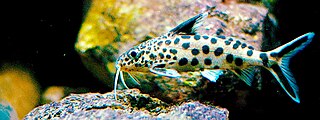
Synodontis multipunctatus, also known as the cuckoo catfish, cuckoo squeaker, or multipunk, is a small catfish from Lake Tanganyika, one of the lakes in the Great Rift Valley system in Africa. It is a brood parasite upon mouthbrooding cichlids. This species grows to a length of 27.5 centimetres (10.8 in) TL. This species is a minor component of local commercial fisheries.

Apistogramma nijsseni is a species of cichlid fish, endemic to highly restricted local black water habitats in the Quebrada Carahuayte, a small stream in the Ucayali River drainage, southern Peru. The male reaches a maximum length of 8 cm (3 in), the female remaining somewhat smaller. Apistogramma brooding females assume a bright yellow and black aposematic coloring: in A. nijsseni, unusually, a healthy, unstressed female retains this coloring. The species is popular aquarium fish amongst dwarf cichlid hobbyists, though it does not often appear in the general pet fish market.
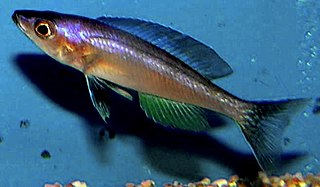
Cyprichromis leptosoma is a mouthbrooding species of fish in the family Cichlidae. It is endemic to Lake Tanganyika in Zambia and Tanzania. It seems quite common within its range and faces no particular threats, so the International Union for Conservation of Nature has assessed its conservation status as being of least concern.

Heroini is a fish tribe from the Cichlasomatinae subfamily in the cichlid family. All cichlids native to the Greater Antilles, United States, Mexico and northern Central America are members of this tribe. It also includes most cichlid species in southern Central America and several species from South America. A large percentage of its species were formerly placed in the genus Cichlasoma, but have since been moved to other genera.

Iranocichla is a genus of fish in the family Cichlidae found in fresh and brackish waters in southern Iran. They are the only cichlids native to this country.

Oreochromini is a tribe of cichlids in the Pseudocrenilabrinae subfamily that is native to Africa and Western Asia, but a few species have been widely introduced to other parts of the world. It was formerly considered to be part of the tribe Tilapini but more recent workers have found that the Tilapini sensu lato is paraphyletic. Despite this change, species in Oreochromini are still referred to by the common name tilapia and some of the most important tilapia in aquaculture —certain species of Oreochromis and Sarotherodon— are part of this tribe. In contrast, several species have small ranges and are seriously threatened; a few are already extinct or possibly extinct.



















